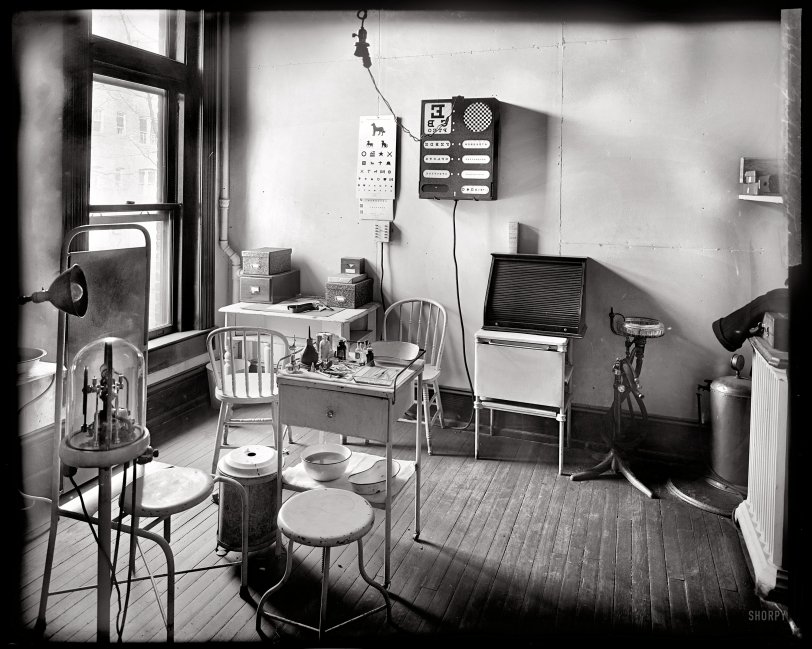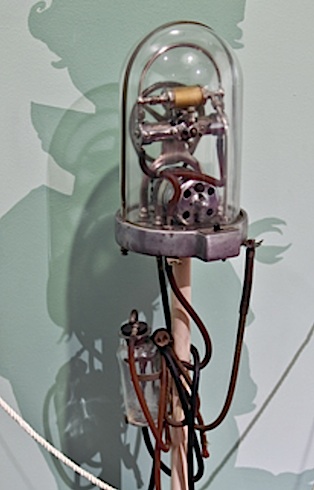


Framed or unframed, desk size to sofa size, printed by us in Arizona and Alabama since 2007. Explore now.
Shorpy is funded by you. Patreon contributors get an ad-free experience.
Learn more.

- Freeze Frame
- Texas Flyer wanted
- Just a Year Too Soon
- WWII -- Replacing men with women at the railroad crossing.
- Yes, Icing
- You kids drive me nuts!
- NOT An Easy Job
- I wonder
- Just add window boxes
- Icing Platform?
- Indiana Harbor Belt abides
- Freezing haze
- Corrections (for those who care)
- C&NW at Nelson
- Fallen Flags
- A dangerous job made worse
- Water Stop
- Passenger trains have right of way over freights?
- Coal
- Never ceases to amaze me.
- Still chuggin' (in model form)
- Great shot
- Westerly Breeze
- For the men, a trapeze
- Tickled
- Sense of loneliness ...
- 2 cents
- Charm City
- What an Outrage
- Brighton Park
Print Emporium
Eye Exam: 1924

Washington, D.C., circa 1924. "Examination room, Garfield Hospital." Home to all the latest equipment. National Photo glass negative. View full size.
Mirrors
Actually, mirrors reverse front and back, not right and left.
Otherwise they would reverse top and bottom too.
This sucks!
The equipment under the dome is a Pilling Suction and Pressure Pump. There's one at the Mutter Museum in Philly.

Distorted
The view through the window has that 'fun house mirror effect', probably due to ripples in the glass. A few years back I was talking with a ranger at Independence Hall about window replacement. She told me that they use an ultra cheap glass produced for greenhouses, since its ripples are nearly as profound as the original, although lacking the small bubbles of the antique glass.
This image is not perverted.
Quite a number of Shorpyites have pointed out that the charts are reversed as they will be viewed in a mirror. The optical "folding" of a room via a mirror has always been an option and is more prevalent today to best use space in an eyecare professional's office.
My other observations are:
Although the vision charts are predominant, this being a hospital setting I doubt that vision care was the primary purpose of the room. The patient's chair is under the charts and the use of a standard room chair would be unlikely in an eyecare office.
Again due to the hospital setting, I expect that the room was used by an ophthalmologist not an optometrist. Also, the District of Columbia was the last area of the US to enacted an Optometry Law in 1924.
The "rolltop" chest to the patient's left likely contains a trial lens set to use to refract the patient (here's an image of a modern set http://www.bibonline.co.uk/products/trial-lens-cabinet-vertical ). The trial lenses would be placed in and out of a trial frame to determine the patient's prescription.
1924 was the first annual observation of Eyesight Conservation Week sponsored by the American Optometric Association. In 1927 it became Save Your Vision Week which is celebrated every March.
Lastly, "perverted" when used in optics describes a reversal of an image. Any flat mirror forms an erect (correct orientation vertically) but perverted (right to left switched) image.
Thanks to Dave for maintaining non-perverted image postings on Shorpy :)
Stock Ticker
The bell jar appears to have a motor on the bottom with a belt driven vacuum pump mounted above it. The vacuum that it produces would probably be used to aspirate fluids from a patient.
That bowl of?
I'm not sure I want to know what's in there.
No wonder they can't see
Some wise guy took the only bulb out of the ceiling! Oh well, at least there's a machine that looks like a stock-ticker in the corner, there. Maybe the good doctor dispensed hot stock tips as well as glasses!
Not Reversed
This picture is not "reversed". The eye charts are viewed in a mirror to allow getting some distance between the patient and the chart. This is still common today.
Okay, I'll tell them.
They are reversed because they are viewed in a mirror. This increases the apparent distance to the eye chart. They still do this in smaller rooms today.
The backwards of backwards
I'm amused to observe that I'm apparently the first commenter to realize that the "reversed" letters in the light box *are going to be projected onto the wall behind the camera*.
What's that under the glass dome on the left?
[Reflected, not projected. -Dave]
Mirror, mirror
The letters are backwards because the patient would look at them through a mirror on the opposite wall. That avails the staff to twice the distance for adjustments. Don't they still do that today?
Mirror
I'll bet the eye chart was made to be viewed via a mirror on the opposite wall (one you can't see). That way they can test for longer distances in a small room. My current eye doc uses a setup like that, but the eye chart is a little more modern.
[Just about all eye doctors use a setup like that. Standard eye tests are viewed from 20 feet away -- that's the "20" in 20/20. Since most examining rooms are not 20 feet across, mirrors are used. -Dave]
Collyrium
Dave is correct. The photo is not flipped. The clincher for me is the small box setting below and to the right of the eye chart. The box contains "COLLYRIUM", an eye wash product.
Backward But
I think the patient would view the eye charts by looking at a mirror on the opposite wall.
Backwards
In regard to the eye chart reversal, I think the patient would be facing the photographer, and would read the eye chart looking at a mirror on the opposite wall, the way it's done in some optometrist's office till' this day.
Newfangled drywall
The installers had not yet learned to stagger the corners or tape and mud the joints on this new construction material.
Not Backwards
Those charts are designed to be looked at in a mirror. Much like modern eye charts, they light up and reflect in a mirror that the patient sees.
This photo is reversed!
Everything is backward!
Literacy not required
Apparently, one did not need to know the alphabet to read the eye chart. Could use some work on sanitation.
["Literact"? "Santitation"? -Dave]
Please don't confuse literacy with my inability to type. What really bothers me is that I have reached the age where my proofreading is not catching these mistakes.
Egad
Let me out of here. This place is enough to give Dr. Frankenstein the willies.
WOW, an Electric Eye Chart
The eye chart is powered by a totally "up to code" power cord wired to the ceiling fixture. The larger cord from the bottom appears to go to the box on the wall with buttons that allow the Doc to illuminate the desired section that needs to be read.
Looking at the chart methinks the negative is flipped since both the electric version and the paper one hiding behind the one with animals have the printing reversed.
[Youthinks wrong. -Dave]
Since I was obviously wrong ... I am guessing here, does the mirror that is mentioned above allow the chart to be used in a room with insufficient distance for using it directly? If that is not the reason then what is the purpose of the mirror method?
That'd make anyone think they were seeing things
Either I'm seeing things or those eye charts and the fancy lightbox are backward, meaning the photo is flopped.
[Incorrect. -Dave]
























On Shorpy:
Today’s Top 5